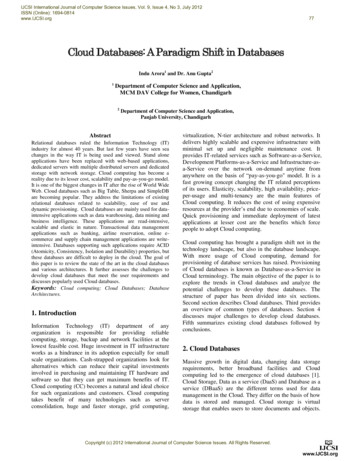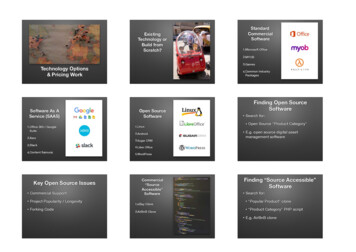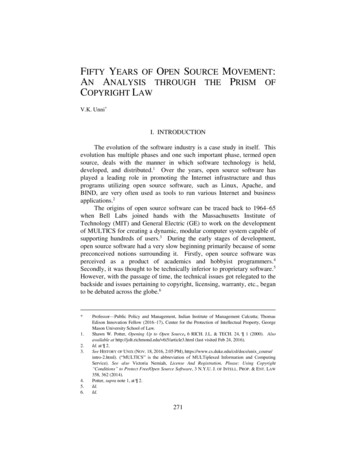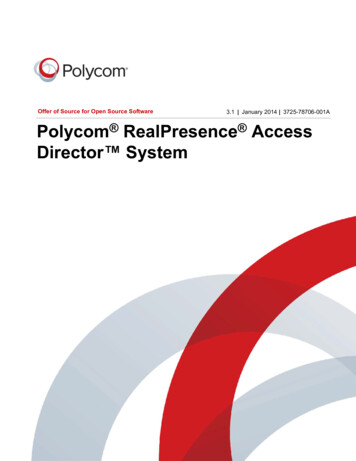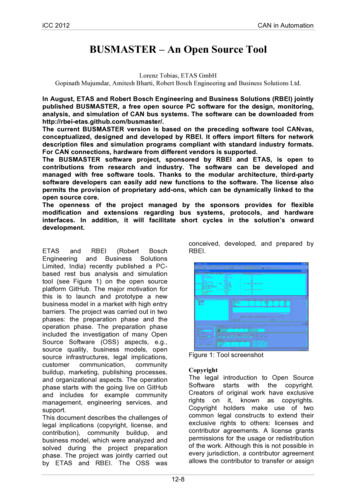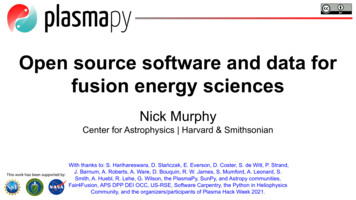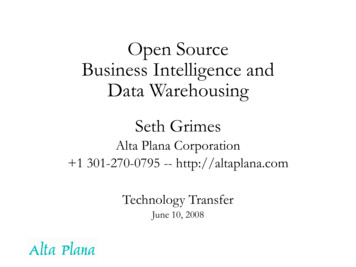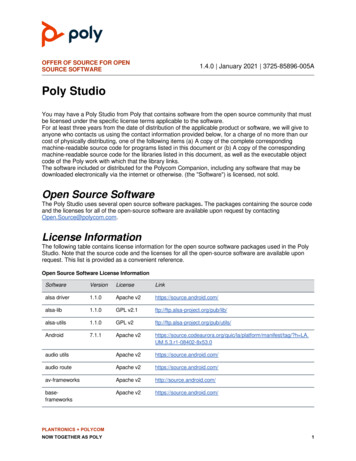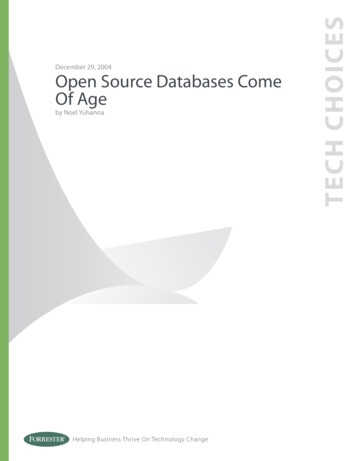
Transcription
Open Source Databases ComeOf Ageby Noel YuhannaHelping Business Thrive On Technology ChangeTECH CHOICESDecember 29, 2004
TECH CHOICESIncludes a Forrester Wave December 29, 2004Open Source Databases Come Of AgeIncreased Adoption, Reliability, And More Choices Drive The Transitionby Noel Yuhannawith Mike Gilpin and Carey SchwaberEXECUT I V E S U M MA RYOpen source databases continue to make inroads into enterprises, offering more robust, highperformance, and advanced DBMS features and functionality as enterprises look for low-cost solutions.More enterprises are deploying open source databases than ever before, with many looking at missioncritical deployments in the coming years. And with more than five viable open source database productsavailable, enterprises now have more flexibility in choosing one that meets their requirements. Morevendors are gearing up to offer comprehensive support and services to meet the growing demand. Thefuture of open source databases remains bright, with products expanding to include advanced featuresand continuing innovation, in addition to enabling evolving technologies like XML, Web services, andcontent management. All enterprises should consider open source databases as part of their overallDBMS strategy to benefit from potential cost savings, starting with small application deployments.TABLE O F CO N T E N TS2 Open Source Databases Have Become MoreViable8 The Current State Of Open Source DatabasesIs Healthy12 The Future Of Open Source DatabasesRemains BrightRECOMMENDATIONS13 Open Source Databases Should Be Part OfYour DBMS Strategy15 Supplemental MaterialN OT E S & R E S O U R C E SForrester interviewed 10 user companies andfive vendors, including: Computer Associates(CA), IBM, MySQL, PostgreSQL, and SleepycatSoftware.Related Research Documents“CA’s Ingres Goes Open Source”June 25, 2004, Quick Take“How To Manage DBMS Efficiently”April 2, 2004, Best Practices“Criteria For Selection: EnterpriseRelational DBMS”July 3, 2003, Planning Assumption 2004, Forrester Research, Inc. All rights reserved. Forrester, Forrester Oval Program, Forrester Wave, WholeView 2, Technographics, andTechRankings are trademarks of Forrester Research, Inc. All other trademarks are the property of their respective companies. Forresterclients may make one attributed copy or slide of each figure contained herein. Additional reproduction is strictly prohibited. For additionalreproduction rights and usage information, go to www.forrester.com. Information is based on best available resources. Opinions reflectjudgment at the time and are subject to change. To purchase reprints of this document, please email resourcecenter@forrester.com.
2Tech Choices Open Source Databases Come Of AgeOPEN SOURCE DATABASES HAVE BECOME MORE VIABLEOpen source databases are not new; they have existed for more than two decades and donot differ much from commercial DBMSes in their support for basic database technology. Sowhy are open source databases becoming more important and viable now than ever before?There are four key reasons. First, enterprises continue to look for opportunities to reduceinfrastructure costs, and commercial DBMS licenses can significantly add to a company’scosts. Second, databases are becoming a commodity, with fewer enterprises demandingadvanced database features. We estimate that the majority of advanced features offered bycommercial DBMS products are hardly used by enterprises; they are sometimes needed,but they aren’t required for many projects. Third, enterprises want to avoid vendor lockin, and open source is one option. Finally, the community resources behind open sourceprojects are often larger than any single vendor can muster, and communities can add newfeatures that enterprises want, rather than what commercial DBMS vendors choose to addbased on more factors than just customer needs.Open Source Databases Offer More Choices Than Ever BeforeThere are more than a dozen open source databases today, and that number is increasing.Five key products dominate the market: Berkeley DB, Cloudscape/Derby, Ingres, MySQL,and PostgreSQL. Most of these products have a long history of releases, with proven trackrecords in commercial deployments (see Figure 1). There is no doubt that open sourceproducts continue to raise the bar with expanded feature lists and advanced capabilitiesthat previously only commercial DBMS vendors offered. We expect more features andfunctions to be added to open source databases in the coming years, enhancing theirscalability, performance, automation, integration, and availability. Also, as open sourcedatabases offer support for more commercial applications, their adoption rate will increase.A recent Forrester survey of 140 large companies in North America found that more than52% of firms use or plan to use MySQL DBMS.1The Open Source Database Market Is Small, But It’s Growing RapidlyWhile open source databases represent only a fraction of the 10 billion overall market fornew DBMS licenses, the market potential is huge in the areas of support and services. Asmore enterprises start to use open source databases over the coming years, the demand for24x7 technical support will increase and so will the need for services to help with planning,migration, and tuning initiatives. We estimate that the current open source database market— comprising new licenses, support, and services — is about 120 million; this figure islikely to grow to more than 1 billion by 2008. More ISVs will jump on the open sourcebandwagon to offer support and services over the next one to two years.December 29, 2004 2004, Forrester Research, Inc. Reproduction Prohibited
Tech Choices Open Source Databases Come Of AgeFigure 1 Open Source Databases Timeline1970Ingres created19751980Relational Technology Inc. (RTI) foundedSiemens DDB-4 created1985Borland Interbase createdPostgres created1990Berkeley DB createdRTI becomes IngresASK Group acquires IngresRenamed Postgres95MySQL createdRenamed PostgreSQLSAP DB createdCA acquires ASK Group1995Cloudscape createdInformix acquires Cloudscape2000IBM acquires Informix Firebird createdBerkeley DB XML createdBerkeley DB JE Cloudscape open sourced2005Berkeley DBDerbyFirebirdSAP DB open sourcedRenamed MaxDBIngres open sourcedIngresMaxDBMySQLPostgreSQLSource: Forrester Research, Inc. 2004, Forrester Research, Inc. Reproduction ProhibitedDecember 29, 20043
4Tech Choices Open Source Databases Come Of AgeSeveral Benefits Have Driven The Adoption Rate Still HigherIn a recent series of interviews, customers indicated that the main reason open sourcedatabases were being used was because of the cost savings. However, Forrester has foundthat low acquisition costs can be offset by somewhat higher integration, maintenance,and support costs over the lifetime of an open source product, so firms should conducta careful analysis to see how these factors apply in their situation.2 The key reasons whyenterprises want open source DBMS are:· Low acquisition cost. Commercial enterprise DBMS licenses currently cost an averageof 25,000 per processor, so this can add up to a significant budget item, especiallywhen deployed for hundreds and thousands of databases across the organization. Withopen source databases, enterprises experience dramatic savings over new DBMS licenses.· Strong support from the community. Open source is all about the community,tapping into hundreds and thousands of developers, contributing to increasedreliability, robustness, and low-cost deployment. Most enterprises using open sourcedatabases claim to have very good support from the community, with responsesprovided by actual developers rather than by support personnel, as is often the casewith commercial DBMSes.· Lower support and maintenance costs. The annual maintenance costs for DBMSesoften run high for many enterprises. Although open source databases can loweracquisition costs, they may not lower lifetime data management costs. Administrativesupport, migration, and upgrade efforts are often the same regardless of whether or notopen source or commercial DBMSes are deployed.· More hardware and software choices. With open source databases, enterprises oftenhave more flexibility in choosing the hardware and operating system platform thatmeets their business and technological requirements. Unlike Microsoft SQL Server,open source databases can run on a variety of operating systems, including Linux,Windows, and several flavors of Unix. However, the value of this flexibility is somewhatoffset by the advantages SQL Server can provide in tighter integration with theWindows operating system.· Access to source code. Enterprises that need to support complex applications oftenfind that open source databases offer greater flexibility in application integration byallowing developers to change source code when necessary. This can be particularlydesirable when the database is deployed along with the application, with a commoninstall.December 29, 2004 2004, Forrester Research, Inc. Reproduction Prohibited
Tech Choices Open Source Databases Come Of Age· Less database vendor lock-in. With open source databases, there is no need to fearthat a DBMS vendor might cease to exist or change its strategy. The major open sourcedatabases are supported by more than one vendor, and enterprises always have accessto source code. This ensures long-term protection, although the cost of dealing withthe worst-case scenarios must also be considered as part of the risk profile.Concerns Exist, But They’re Slowly Fading AwayEnterprises that are looking to adopt open source databases are concerned about the levelof support and the time it takes to resolve issues. Many enterprises are used to the 24x7support offered by commercial database vendors, with quick turnaround and resolution.While open source database vendors might not have a large support staff, enterprisescertainly have a choice of vendors available to meet their support requirements. Recentuser interviews revealed that key concerns around open source DBMSes include:· Support quality. Although open source support is improving, it’s still not comparableto commercial DBMS support. Commercial DBMSes have always offered high-quality24x7 support for enterprises, surpassing the best level of support offered by opensource databases, although this is beginning to change. Many open source databasevendors are gearing up to offer higher-quality support and improved, searchableknowledge bases. Large vendors will offer even more support options and services overthe next two years.· Product maturity. While many enterprises encountered a high degree of reliabilitywith many open source database products, the concern about product maturityremains. Yet the top five open source databases are mature and stable, surpassingthis expectation. For example, one enterprise that runs Ingres for a mission-criticalproduction database application stated that it ran Ingres for more than a year withoutshutting down, except when an upgrade was necessary. And most open sourcedatabases have a long history of product releases, some even surpassing those found incommercial DBMSes.· Support for packaged applications. Although there are not as many packagedapplications supported for open source databases, the number continues to grow andshould largely eliminate this concern over the next two to three years. Many large ERP,CRM, and other business application vendors are considering supporting open sourcedatabases because of the growing market. Some are also building their own opensource stacks to ship along with their applications. 2004, Forrester Research, Inc. Reproduction ProhibitedDecember 29, 20045
6Tech Choices Open Source Databases Come Of Age· Security. All database products, whether commercial or open source, are vulnerable,largely because a DBMS is a complex piece of software. Many commercial DBMSeshave experienced several security vulnerabilities over the past few years. Enterprisesremain concerned about the security and reliability of open source databases, giventhat source code is easily available to any hacker. While this is true, it is at least partlyoffset by the larger community of the open source initiative driving the product toundergo a rigorous review to ensure robustness and reliability. Having access to theopen source database source code also reduces anxiety about whether the vendor willexist in the future, helping to ensure long-term protection, although in some cases,source escrow programs for commercial DBMS provide the same benefit.Most Deployments Are Not Mission-Critical, But That’s ChangingWhile most of the open source database deployments are for non-mission-criticalapplications or edge workloads, we estimate that more than 35% of applications using opensource DBMS will be mission-critical by 2006. Most open source database deploymentssupport applications developed in-house, reporting databases, read-only applications, anddata warehouses. Over the next two years, there will be a major push toward deployment oftransactional databases using open source databases for both existing and new applications.Most enterprises typically spend more than 12 months testing and understandingopen source database products before deploying them for mission-critical applications.This approach not only flushes out unknowns around support, product limitations orissues, and reliability, but it also gets the staff trained on the platform. Most customerdeployments start out small and grow once the staff feels comfortable with the technologyand as administrators get a handle on its operations. The most common applications usingopen source databases today include:· Web-based applications.· Small to midsize transaction-processing applications.· Small to midsize data warehouses and data marts.· Scientific applications like DNA sequencing or seismic analysis.· Reporting databases.· Directories and email repositories.· Data repositories.December 29, 2004 2004, Forrester Research, Inc. Reproduction Prohibited
Tech Choices Open Source Databases Come Of AgeOpen Source Databases Will Continue To Affect Commercial DBMSesWhile open source databases will not replace the commercial enterprise DBMSes like DB2,Oracle, SQL Server, and Sybase, they will certainly take a bite out of large DBMS marketshare. As a result:· Commercial DBMS prices will fall. DBMS vendors continue to feel competitivepressure from open source DBMSes and are likely to lower prices over the next 12to 24 months in an effort to directly compete with them. The current impact of opensource databases is in the low-end market, but it will expand into the mid- and highend markets over the next three to five years. Earlier this year, Oracle reduced itspricing for entry-level DBMS products, and other vendors are likely to follow suitin one to two years. Other likely competitive responses include incorporating opensource technology into the vendor’s own offering, especially for vendors like IBM thatalready embrace open source in other areas.· Some vendors will adopt a free database strategy. Sybase recently announced a freeversion of its Adaptive Server Enterprise (ASE) product on Linux; its free ASE hasattracted some customers but, because of usage limits, will likely fall short of customers’expectations. Its limitations include a maximum 2 GB database size, one CPU server,and 2 GB of memory. More vendors will adopt this strategy in an effort to attract newcustomers, but these vendors will set higher limits.· Commercial DBMSes will have to innovate to retain customers. The features gapbetween open source databases and commercial DBMS products is narrowing. Whilecommercial DBMSes offer hundreds and thousands of database features, we estimatethat only 40% of such features are typically needed by enterprises. This is one of thereasons why open source databases have become attractive; open source databasesprovide the basic database features and functions that most applications need. Butcommercial DBMS vendors will add highly innovative new features to retain largeenterprise customers.Source Code Is Nice To Have But Not A NecessityA DBMS is a complex piece of software, which is why the majority of enterprises look at thesource code to better understand how to use the DBMS but do not modify it. Enterprisesthat do modify the code usually do so to ensure tighter integration of their applicationsor to extend the product beyond its existing capabilities. Having access to the open sourcedatabase source code also reduces anxiety about whether the vendor will exist in the future,helping to ensure long-term protection. 2004, Forrester Research, Inc. Reproduction ProhibitedDecember 29, 20047
8Tech Choices Open Source Databases Come Of AgeSupport Remains Critical When Choosing An Open Source DatabaseOpen source databases offer two ways to obtain support for the product. The first option isto get support from various vendors that offer technical support through phone and email,often for less than the price of commercial DBMS support. The benefit of vendor supportis that most offer 24x7 phone support, which is essential for mission-critical applications.Some vendors also offer an extensive knowledge base; some are free while others areavailable for a small fee. The second option is to get support from the open sourcecommunity via message boards and emails. The benefit with community support is that aresponse usually comes directly from actual developers, who know the code inside-out andtherefore often resolve the issues quickly.Most Deployments Are For Newer ApplicationsThe majority of open source database deployments are for new applications, ratherthan migrations of existing ones, at least for now. Enterprises typically use open sourcedatabases for small, non-mission-critical database deployments initially before extendingtheir usage within the organization. Database migrations are time-consuming, resourceintensive, and costly. Also, most DBMS products differ in the data types they supportand often use proprietary SQL extensions for creation of triggers, stored procedures,and functions. Therefore, we expect that the majority of initial open source databasedeployments will be for new applications, with migrations of existing databases rolling outover the next two to three years as more migration tools become available and enterprisesbecome more comfortable with the technology.The Database Tools Market For Open Source Is GrowingOver the past year, the number of database tools that focus on open source databaseshas increased. Enterprises are demanding more robust and integrated tools for opensource databases to ensure their availability and performance. In the near term, variousvendors will introduce tools in the areas of migration, replication, archiving, and security.Quest Software now offers its popular Toad tool on the MySQL platform to help bothadministrators and developers. By 2007, the growth in database tools support shouldlargely eliminate the current deficit in support relative to commercial DBMS, whichinflates the cost of ownership of open source options.THE CURRENT STATE OF OPEN SOURCE DATABASES IS HEALTHYMore enterprises are ready to commit to open source than ever before, and others areextending their portfolio to support mission-critical applications. This year alone, twonew large vendors joined the open source database bandwagon: Computer Associateswith Ingres, and IBM with Cloudscape. The move to open source these databases hascertainly raised the bar on the quality, performance, and reliability of open source databases.December 29, 2004 2004, Forrester Research, Inc. Reproduction Prohibited
Tech Choices Open Source Databases Come Of AgeWe conducted a Forrester Wave evaluation of the five key open source database products,namely Berkeley DB, Cloudscape, Ingres, MySQL, and PostgreSQL. We compared thesetools in a number of areas, including transactional capability, security, market presence,and data warehousing capability, standards, and support (see Figure 2). Our findings:· MySQL remains the most widely used but lacks some key features. MySQLcontinues to have a very high adoption rate across several industries and is knownfor its reliability, ease of use, and performance. It is a full, relational DBMS, and itsupports row-level locking and deadlock detection functionality. However, it lackssome key DBMS features, such as triggers, stored procedures, and views, which arelikely to be available in Version 5. These features are likely to boost MySQL to evenhigher adoption rates and may open doors for support for more packaged applicationsand tools. At present, there are many large enterprises that run MySQL to support bothmission-critical and non-mission-critical applications.“We have more than 20 MySQL production databases supporting our mission-criticalapplications. Basically, we depend on it. MySQL is the back end for our Web site, whichgets more than 30 million hits a day. We are satisfied with the performance, availability,and support with MySQL. Besides, it saves us lots of money over commercial DBMSeslike Oracle.” (Online community Web site)Figure 2 Forrester Wave : Open Source Databases, Q4 ’04The spreadsheet detailing this Forrester Wave is available online.RiskyStrongBets Contenders PerformersLeadersStrongMarket presenceIngresPostgreSQLCloudscapeMySQLBerkeley DBCurrentofferingWeakWeakStrategyStrongSource: Forrester Research, Inc. 2004, Forrester Research, Inc. Reproduction ProhibitedDecember 29, 20049
10Tech Choices Open Source Databases Come Of Age“We use MySQL extensively in our environment. For our Web site, which has morethan 6 million unique visitors per month, we track all events created by user activityand store the state and session in MySQL. We also use MySQL to track the emailsthat we send out each week in a large data warehouse that has more than 300 millionrows. MySQL doesn’t have some of the advanced features that Oracle has, but it meetsour business requirements. Our application is mainly written in Java and some PHP/Perl. The MySQL community is very active, so getting support and guidance has beenvery effective. MySQL is easy and flexible to work with; we can get MySQL and ourapplication running very quickly.” (Entertainment company)“We looked at MySQL and Oracle at the very beginning and found that MySQL was a loteasier to configure, set up, and run, even though we had experience with Oracle. WithOracle we often had to hire an outside consultant to come to help with administration;with MySQL we never had to. MySQL has not only saved us money on licensing fees,but it also made our databases easier to manage. Adopting MySQL has been one of thebetter decisions that we have made. We do not see any limitations with MySQL DBMSfor our application.” (Online retailer)“We have not changed the source code of MySQL for our application, but being able toreview it is incredibly valuable to us. It is a lot easier to troubleshoot with open sourcethan to go to commercial support all the time. We are always looking to deploy moreapplications with MySQL because it’s easy to use, it’s flexible, and it saves us money.”(Entertainment company)· Ingres raises the bar for open source databases with expanded features. Ingres is themost complete open source relational database. It has been around for more than twodecades and is well known to have advanced enterprise-class features and reliabilityon par with many commercial DBMSes. CA recently made Ingres open source in aneffort to make Ingres more visible and grow CA’s services and tools business. WithIngres going open source, the bar for features, functionality, and support is certainlyhigher for open source databases. CA’s move to open source Ingres might trigger other,smaller, commercial DBMS vendors to follow suit, especially for their slow-movingdatabase products.“Ingres has been our primary database platform for the past 10 years. We have a largesubscription system that processes information about members who need to accessairport lounges across the world. This application is running on a Linux/Red Hatenvironment. We wanted an enterprise database that was affordable to us; we invitedOracle to give us a quote, and it was laughable. Ingres R3 is a lot easier to install anduse, and because it’s an open source product, more vendors are likely to offer plug-insinto their tools and applications, which will broaden the market. With Ingres you getan enterprise database at a very low cost.” (Travel services company)December 29, 2004 2004, Forrester Research, Inc. Reproduction Prohibited
Tech Choices Open Source Databases Come Of Age“We’ve deployed Ingres for several in-house applications, including for a report server.We have been using Ingres for more than nine years, and we are pleased with itsperformance, reliability, and enterprise-class functionality. Our report server, whichtracks information from various stores, is around 750 GB in size and growing. Whilethe number of users is not high with the report server, we load more than a milliontransactions a day on it. We also use Ingres for the general ledger mission-criticalapplication that has close to 250 concurrent connections. Our business depends onIngres to support our critical applications.” (Retail company)· IBM’s Cloudscape/Apache Derby remains a viable DBMS. Recently, IBM opensourced Cloudscape RDBMS and contributed it to the Apache Software Foundation(ASF) under the code-name Derby. Cloudscape is an embedded Java databasethat supports SQL92 and parts of SQL99. It has a small footprint and requires noadministration. It was originally part of Informix’s product line; Informix was acquiredby IBM in 2001. Cloudscape has always been behind the scenes, having a very lowcustomer base and lack of visibility across the industry. However, open sourcingCloudscape might spur higher adoption and increased innovation. Besides Cloudscape,other open source Java databases include Berkeley DB Java Edition from Sleepycat andthe less well-known McKoi SQL Database.While there aren’t many customers using Cloudscape, IBM has used the technologyquite extensively to support more than 70 projects, including WebSphere, Tivoli, andLotus Workplace. For customers that outgrow Cloudscape/Derby and wish to upgrade,IBM offers a full upgrade path to DB2. Potential uses of Cloudscape include support ofJava applications for data repositories, directory services, and Web-based applications.Besides Java, Cloudscape also supports .NET programming environments using theODBC interface. IBM offers an optional 24x7 support for Cloudscape/Derby throughthe IBM Cloudscape package.· PostgreSQL has good features with moderate adoption. PostgreSQL and Ingresshare a family history; both were created by Michael Stonebraker and his grad studentsat Berkeley. Because of this, PostgreSQL has strong enterprise DBMS features andfunctionality. PostgreSQL is a full, relational DBMS with core transactional capabilitylike ACID properties and deadlock detection. It has many database features that areessential for business applications, such as triggers, functions, BLOBs, and views. Thecurrent version supports stored procedures using functions, but 100% SQL-syntaxcompatible stored procedures will be available in version 8.1.“We are using PostgreSQL in production for our critical applications, includingrunning our Web site. PostgreSQL had all of the features and functionality that weneeded for our application, including embedded SQL and transactional capability. Itcertainly has saved us money, besides giving us a high-quality database. The speed of 2004, Forrester Research, Inc. Reproduction ProhibitedDecember 29, 200411
12Tech Choices Open Source Databases Come Of Agethe PostgreSQL database has been phenomenal, besides being reliable and runningwithout any issues. The PostgreSQL Web site contains a lot of documentation andFAQs that have been helpful.” (Entertainment company).“We run real-time, mission-critical databases using PostgreSQL for our registry of Websites. PostgreSQL is the core of the application, and if it goes down, all registrations andmodification will cease. We found PostgreSQL very easy to administer; it conformsto the best practices in the industry. PostgreSQL has a very rich set of tools that coverbroad areas from an end-user graphical tool to a command-line utility for experts.PostgreSQL is a mature database; we run it every day supporting our mission-criticalapplications. It has very good database features and supports high availability andmission-critical usage.” (Internet company)· Berkeley DB is widely used and well integrated with applications. Berkeley DB isa developer database that is available as a C library or Java JAR file for easy integrationwith applications. It comes in three flavors: Berkeley DB Java Edition, Berkeley DB, andBerkeley DB XML. Key features include ACID properties to preserve transactionalintegrity and automatic recovery after failures, concurrent access, deadlock detectionand resolution, and replication for high availability. While Berkeley DB supports manyenterprise-class features, it is not a relational database and does not support SQL.Berkeley DB offers easy-to-use, programmatic APIs with language bindings for C, C ,Java, Tcl, Perl, Python, and PHP.“We have been using Sleepycat Berkeley DB for the past two years for our enterprisesoftware. Our applications are becoming more complex, with SAN storage andcomplex hardware infrastructure. We use the Berkeley DB to share information amongvarious applications related to resources. Berkeley DB is a small, easy, and fast databasethat is critical for our product. We did not need complex queries or complex databases;we just needed a simple and easy-to-use database with no administration requirements,and Berkeley DB delivered that. We hardly ever use Sleepycat’s support because of theproduct’s reliability. Although we have looked at the source code, we haven’t felt
open source databases, enterprises experience dramatic savings over new DBMS licenses. · Strong support from the community. Open source is all about the community, tapping into hundreds and thousands of developers, contributing to increased reliability, robustness, and low-cost deployment. Most enterprises using open source
